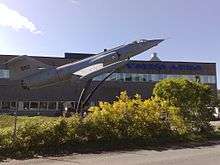Volvo Aero
|
| |
| Industry | Aerospace |
|---|---|
| Fate | Acquired by GKN |
| Successor | GKN Aerospace Engine Systems |
| Founded | 1930 |
| Defunct | 2012 |
| Headquarters | Trollhättan, Sweden |
Number of locations | Trollhättan, Linköping, Kongsberg (Norway), Newington, Connecticut (US) |
| Parent | Volvo |
| Website |
www |


Volvo Aero was a Swedish aircraft, guided missiles[1] and rocket engine[2][3] manufacturer. In 2012, the company was acquired by GKN, becoming GKN Aerospace Engine Systems.
History
Nohab Flygmotorfabriker AB was founded in Trollhättan, Sweden, in 1930 to produce aircraft engines for the Swedish Board of Aviation. As the name of the company indicates it was a subsidiary to NOHAB. In 1937 it became a part of the newly founded SAAB but in 1941 Volvo acquired a majority of the stock and the name was changed to Svenska Flygmotor AB (SFA), and later on Volvo Flygmotor.
Since the 1950s the company has been the major engine supplier to the Swedish Air Force. The Volvo Aero Group has 3,600 employees and in 2003 had total sales of 0.9 billion euros. Today Volvo Aero is a partner in more than ten commercial engine programmes. Components from Volvo Aero are installed in more than 90% of all large commercial aircraft engines sold.[4]
On 6 July 2012 Volvo Aero was acquired by the British aerospace manufacturer GKN in a SEK 6.9 billion deal.[5]
Test facility
In the 1950s, the Swedish Air Board constructed an unusual test facility at Flygmotor. This was an engine test facility, a form of wind tunnel, which could operate at high inlet pressures, thus high Reynolds numbers. This tunnel was unique in being water-powered. A sealed underground chamber was blasted out of the granite beneath the Göta Canal. When the canal was allowed to flood the chamber, air was driven from it at high pressure and through the test chamber. A supersonic test of an engine could be carried out for around 10 minutes, after which it took 24 hours to pump the chamber dry again.[6] Use of this test facility was shared with Rolls-Royce, who used it in 1953 to develop the afterburners of the Avon RA7 engine for the Supermarine Swift F3 and Saab 32 Lansen.[6] The Avon RA14 afterburner would also be tested here, produced as the Flygmotor RM6B for the Saab 35 Draken.[7]
Products
Aircraft engines and components
Volvo Aero is a supplier of single-engine systems for military aircraft. These have largely been in partnership with other engine manufacturers, such as the RM1 (de Havilland Goblin) for the Saab 21R, RM2 (de Havilland Ghost) for the Saab J29, RM5 and RM6 (Rolls-Royce Avon) for the Saab 32 Lansen, the RM6B for the Saab 35 Draken, and the RM8 (Pratt & Whitney JT8D) for the Saab 37 Viggen. The Saab JAS 39 Gripen's RM12 engine is a derivative of the General Electric F404.
Svenska Flygmotor also designed the B42, horizontally-opposed four-cylinder engine, intended for the SAAB Safir. However, SAAB decided to use engines from de Havilland and Lycoming instead. In the end the B42 came to power the Infanterikanonvagn 103 assault gun. A follow-up called B44 powered the Pansarbandvagn 301 armoured personnel carrier.
Volvo Aero delivers engine components, mainly complex engine structures like turbine exhaust casings, turbine mid frames, LPT cases, compressor housings, LPT shafts, vanes, and large rotating parts.
Engine maintenance and service
Volvo Aero also has a facility in Trollhättan where they did maintenance on aircraft engines and stationary gas turbines. The aircraft engines are Pratt & Whitney Canada PW100 and TFE-731 engines. The Stationary gas turbines is General Electric LM1600 engine, and the DR990, which Volvo bought the OEM responsibility from Dresser Rand.
Formed in 1979, US aftermarket aircraft parts seller AGES Group was sold to Volvo Aero in 1999 to form Volvo Aero Services. In 2011, VAS Aero Services was sold to HIG Capital and returned to being privately held in 2017. It employs over 200 worldwide.[8]
Space propulsion
Volvo Aero manufactures combustion chambers, nozzles and turbines for commercial launch vehicles.
Hydraulic Motors
The company have produced the F-series hydraulic motors under the Volvo Flygmotor, "Volvo Hydraulics" and VOAC brands. The main feature of these products are the spherical pistons each with a laminated segment. This technology permits a large angle (40°) between the shaft and the cylinder barrel.
Locations
Volvo Aero subsidiaries are located in the United States and Norway, in addition to Volvo's home country, Sweden. The Norwegian plant, in Kongsberg, is the former Norsk Jetmotor, itself formerly a part of Kongsberg Våpenfabrikk.
References
| Wikimedia Commons has media related to Volvo Aero. |
- ↑ New Rocket, Missile Designs Shown at Paris, Aviation Week & Space Technology, June 24, 1963, v. 78, no. 25, p. 75.
- ↑ High activity in Sweden, Flight International, 14 December 1972, v. 102, no. 3327, p. 12.
- ↑ Wetmore, Warren C. RM-8 Detail Design Pushed by Flygmotor, Aviation Week & Space Technology, November 18, 1963, v. 79, no. 28, pp. 48-51.
- ↑ Volvo Aero Official Website
- ↑ AB Volvo divests Volvo Aero to British GKN for SEK 6.9 billion
- 1 2 Elliott, Cyril; Goodwin, John (2001). "Chapter four: Rolls-Royce Avon Engines". Fast Jets - The history of reheat development at Derby. R-RHT. pp. 40–41. ISBN 1-872922-20-1. Technical Series Nº5.
- ↑ Elliott & Goodwin (2001), p. 48.
- ↑ "About us". VAS Aero Services.